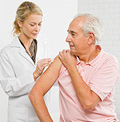 In 2009, health ministers from around Europe pledged to vaccinate 75% of older people against seasonal influenza but, five years on, most have fallen well short.
In 2009, health ministers from around Europe pledged to vaccinate 75% of older people against seasonal influenza but, five years on, most have fallen well short.
A report by the European Commission says that only the Netherlands reached the 75% target, while the UK came close with 74% coverage. In some countries, less than 2% of older people are vaccinated against the flu.
Older people, healthcare workers, pregnant women and people with chronic illnesses are among the ‘at risk’ groups prioritised for vaccination because the flu virus hits them hardest.
Read/Watch: Who should have the flu vaccine and why?
Every year, around 10% of the European population is infected by influenza but vaccines can reduce the impact of chronic diseases in the elderly and keep older people out of hospital.
<iframe width=”560″ height=”315″ src=”//www.youtube.com/embed/tDfuiTjxeCU” frameborder=”0″ allowfullscreen></iframe>
So why are flu vaccination rates so low?
The EU report offers several reasons. For a start, people underestimate the risk of getting the flu – especially in hospitals and health centres. And there are unfounded fears that the vaccine causes flu (even though the flu vaccine is an inactivated vaccine).
After that, cost, convenience, misleading media reports and questions about the effectiveness of the vaccine combine to suppress vaccination rates.
The good news is that you don’t have to wait for your Health Minister to protect you from infection. Ask your healthcare provider if you should have the flu vaccine this year. And ask them again next year. And the year after that…
Are you in one of the WHO priority target groups?



